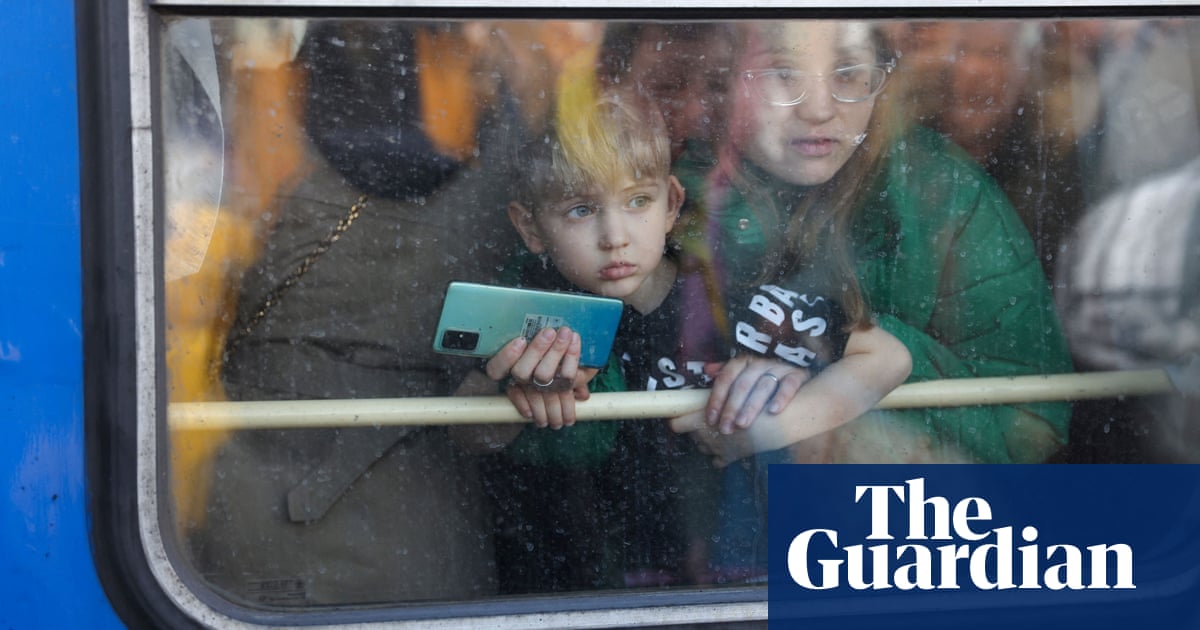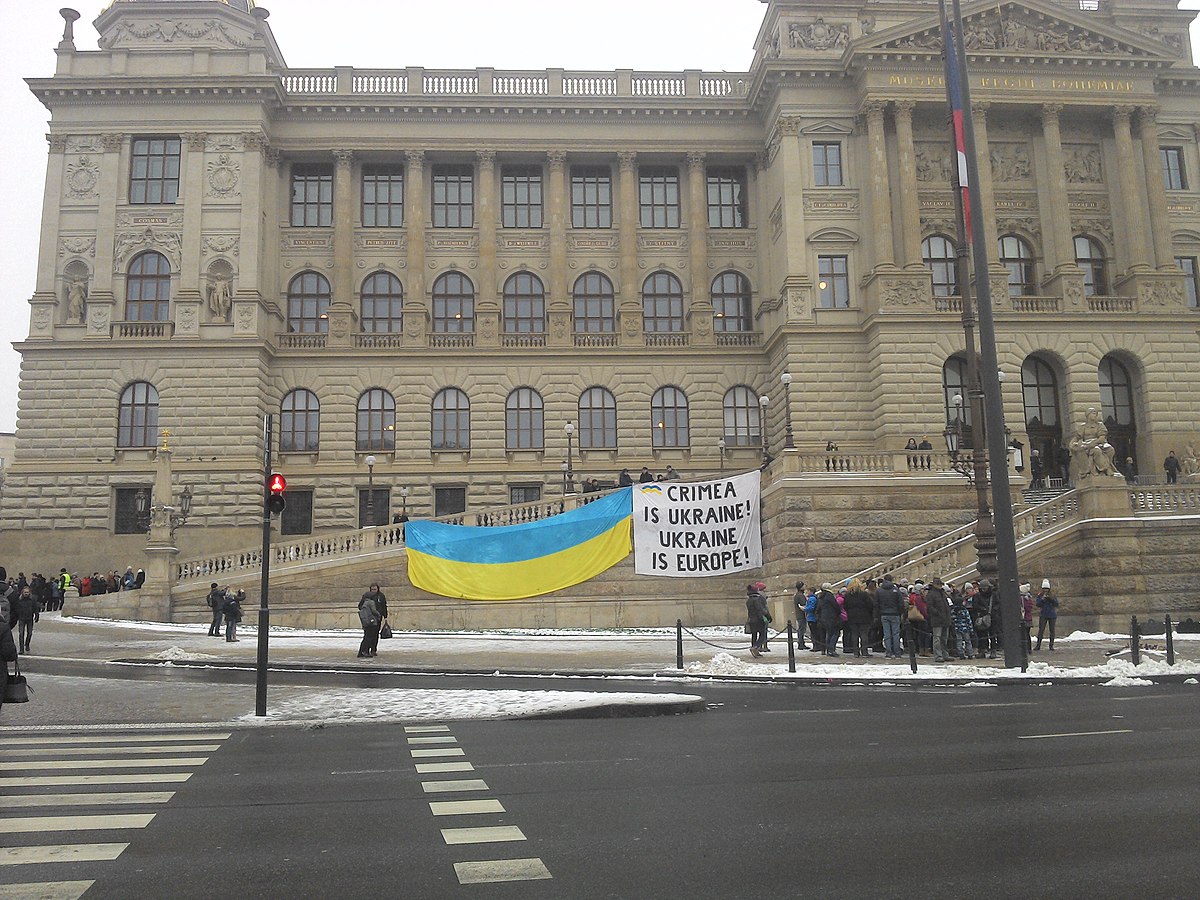No To War
Shared Article from The Guardian
The battle for Kyiv: 'People are grieving. This is already a tra…
Residents of Ukrainian capital express shock and anger as invading Russian troops bring death and destruction
Emma Graham-Harrison @ theguardian.com
While it is not yet clear what future Vladimir Putin envisages for Ukraine if his invasion succeeds, it is clear he wants to hold the capital and dismantle the government of Volodymyr Zelenskiy, which he attacked on Friday as a
gang of drug addicts and neo-Nazis.Zelenskiy, who is Jewish, has vowed to stay in the city to fight for it, despite offers of evacuation. On Friday evening he posted a video, filmed on the streets of the capital, showing him in military fatigues and standing with the prime minister and other key political leaders, proving he had not fled.
All of us here. We are defending our independence. And we will continue to do so. Glory to our male and female defenders. Glory to Ukraine.. . . City authorities had urged residents to stay home but prepare molotov cocktails for a citizen uprising against Russian fighters if they broke through defensive lines. In one district they handed out rifles to any citizen who wanted to fight and the defence ministry opened the army to any Ukrainian citizen.
Bring only your passport and social security number. There are no age restrictions,the ministry said in a public post.. . . Many Kyivites spent the night in metro stations or bomb shelters because of these warnings [rumors of a coming all-out ground assault], perhaps one reason why the missile strike caused so much damage but only injured four people. It was one of a series of blasts that shook the city awake soon after 4am; another was caused by a Russian plane that crashed into residential buildings. The wail of air raid warning sirens followed soon after, calling those not already underground to take shelter.
. . . There were gunfights reported in northern Obolon district and photos circulated of soldiers readying to defend Podil, a riverside port district that is home to a historic university and crammed with fashionable bars and restaurants that make it Kyiv’s answer to Brooklyn in New York or Shoreditch in London.
The days-long fight for control of Hostomel airport on the city outskirts, which has a long runway that would allow Russia to land heavy transport planes, intensified. Elsewhere, in parts of the city where the war had not quite arrived, the streets were eerily empty, apart from long but calm queues outside pharmacies and supermarkets, as a remarkably stoic population stocked up for a possible siege.
The city council asked citizens to stop livestreaming the streets and avoid posting pictures of soldiers and army positions, in case it aided Russian troops. Only the roads leading westward to relative safety were still crammed, as a last surge of refugees tried to escape the coming bloodshed. The caravan of cars, most packed with people, pets and possessions, often came to a complete halt as roads were overwhelmed by the flood of exiles.
The railway station was also swamped with crowds desperate to escape. Guards fired warning shots at one point to prevent a stampede among hundreds of people who stormed carriages as they pulled in. Those who stayed took heart from news of Ukrainian forces’ success in many battles around the country, which apparently slowed plans to encircle Kyiv.
. . . Videos also circulated on social media showing unarmed Ukrainians attempting to tackle the invaders, including one of a man stopping a convoy of armoured vehicles by running into the road and shouting at them. Another showed a woman shouting abuse at soldiers and telling them to put sunflower seeds in their pockets, so when they were killed on Ukrainian soil, flowers would grow from their corpses.
But for all the mood of defiance, there was also a resignation to bloodshed ahead, in an all-out fight against an enemy whose tactics in other wars have included targeting civilians.
Anatoly Grigovivch, 64, had defied the air raid sirens to race over to his daughter’s legal firm, which had been torn apart by the missile that exploded next to the apartment block. He was worried about looters.
I wouldn’t have minded if they hit that tax office,he said, grimacing after climbing through what was once a glass door.They just hit people with this missile, do you see any tanks here?— Emma Graham-Harrison, The battle for Kyiv:
People are grieving. This is already a tragedy
The Guardian, 25 February 2022.
Shared Article from ICNC
Ukrainians vs. Putin: Potential for Nonviolent Civilian-based Defense
With more than 150,000 Russian troops staged along on the Ukrainian border, and also massing in Belarus and the occupied territories of Crimea and Don…
Maciej Bartkowski @ nonviolent-conflict.org
. . . If Putin decides to launch a full-scale military invasion, it will be because he thinks that he will achieve rapid military victory over his much more powerful forces over the Ukrainian army, even if the latter receives military support from the West. If he pushes his offensive all the way to Kiev, it would also signal his belief that the current Ukrainian government would be quickly removed from power and replaced by a puppet pro-Russian regime. Alongside is his view that the majority of the Ukrainian people would passively accept the Russian invasion and occupation in the same way the majority of the population inside Donbas and Crimea did from 2014 onward. After all, Putin claims Russians and Ukrainians are the same people and have simply been separated from each other by the Ukrainian nationalist elite. According to his rhetoric, once this elite is removed from power, Ukrainians would gladly accept reunification with Russia.
To influence Putin’s calculus about the full-scale invasion, some in Ukraine and the West emphasize that Ukrainians are ready for protracted guerrilla warfare and that Ukraine could be for the Russian leader what Afghanistan became for the Soviets. However this scenario, if realized, would be equally painful for Ukrainians as it would be for Russians. After all, Afghanistan was left in ruins and hundreds of thousands of people were killed and became refugees, even if eventually they prevailed over their invaders.
Putin’s assumptions are dangerous miscalculations with potentially terrible consequences for Ukrainians.
. . . In 2015, the Kiev International Institute of Sociology (KIIS) conducted a representative national survey[1] that for the first time ever assessed Ukrainians’ preferences for resistance in case of a foreign armed invasion and occupation of their country. The poll took place just after the Euromaidan revolution and the capture of Crimea and the Donbas region by Russian troops, when it could be expected that Ukrainian public opinion would be strongly in favor of defending the motherland with arms. The results, however, revealed surprisingly strong support for an alternative to an armed-defense type of resistance: civilian-led nonviolent defense. The survey showed that the most popular choice of resistance among Ukrainians was to join nonviolent resistance: 29% supported this choice of action in case of foreign armed aggression and 26% in case of occupation. In contrast, armed resistance was supported by 24% and 25% respectively. See Figure 1. Only 13% of Ukrainians would behave in the way Putin would hope in case his troops invade Ukraine–do nothing. . . . Furthermore, according to the survey, those among Ukrainians who seek to protect territory are more willing to take up arms. Those seeking to protect their families and communities would rather turn to nonviolent resistance methods.
. . . Ukrainians do not necessarily embrace the idea of an Afghan scenario in which an armed guerrilla movement wages warfare against invaders that is equally destructive for the local population. Instead, they view unarmed defense and resistance of the civilian population not only as a plausible alternative that can better protect the population and minimize human costs of violent conflict but also as a way to achieve victory against a militarily stronger opponent . . . . Ukrainians show a surprising level of support for the type of resistance that neither Ukrainian policymakers nor their Western backers have considered in their defense planning: mass nonviolent resistance actions against a formidable military invader. This human potential for nonviolent resistance remains unfortunately untapped in the Ukrainian national defense strategy . . . .
— Maciej Bartkowski, Ukrainians vs. Putin: Potential for Nonviolent Civilian-based Defense
International Center on Nonviolent Conflict, 27 December 2021.
Shared Article from nytimes.com
Thousands of Russians protest President Vladimir V. Putin’s as…
At the demonstrations, many people said they felt depressed and broken by the news of Russian military action.
nytimes.com
In Moscow, the police blocked off access to the Pushkinskaya Square in the city center, after opposition activists called people to come there. Police officers dispersed even the smallest groups of protesters, ordering them to clear the area through loudspeakers.
A few hundred people, mostly young, flanked the streets leading to the square, some chanting
No to war![2] and unfurling a Ukrainian flag. The police detained more than 600 people in the city, according to OVD Info, a rights group that tallies arrests.
The world has turned upside down,said Anastasia, 44, bursting into tears after seeing that the square was not full of people.Everyone must be here, it is the only way to show that something monstrous is happening,she said, refusing to give her last name fearing repercussions from security services.. . .
In St. Petersburg, Russia’s second-largest city, riot police officers rounded up at least 327 people who came to the Nevsky Prospekt, the city’s main thoroughfare.
Wearing helmets and in full gear, they hit people and pushed protesters to the ground, according to video footage from the scene. Many people came out in other Russian cities, including in Yekaterinburg, a major city in the Ural Mountains, where protesters chanted
No to war![3] in front of a Lenin monument.Overall, more than 1,300 people were detained across the country, OVD Info reported. . . .
— Ivan Nechepurenko and Dan Bilefsky, Thousands of Russians protest President Vladimir V. Putin’s assault on Ukraine. Some chant:
No to war!
New York Times, 24 February 2022.
Shared Article from nytimes.com
Russia says it will limit access to Facebook, a major platform f…
Since President Vladimir V. Putin launched his attack on Ukraine, many Russians have taken to social media to express their anger.
nytimes.com
MOSCOW — The Russian government said it was partially limiting access to Facebook for restricting some pro-Kremlin news media accounts, a move that could make it harder for Russians to share their anger over their country’s invasion of Ukraine.
The Russian telecommunications regulator, Roskomnadzor, said Facebook was
involved in the violation of fundamental human rights and freedomsbecause it had limited access to four Russian media accounts, including that of the state-run news agency RIA Novosti and of the Defense Ministry’s television channel, Zvezda. Starting Friday, Roskomnadzor’s statement went on,measures are being taken to partially limit access.. . . Major American online platforms like Facebook, Instagram, YouTube and Twitter remain accessible in Russia, allowing a space for dissent that does not exist on television.
Since President Vladimir V. Putin launched his attack on Ukraine on Thursday, many Russians have taken to social media to post expressions of shame and anger. Rights activists in Russia have voiced concern that the Kremlin would mount a new crackdown on freedoms in the wake of the invasion.
— Anton Troianovski, Russia says it will limit access to Facebook, a major platform for dissent.
New York Times, 25 February 2022.
- [1]The survey results were first described and presented in English in the coauthored article “To Kill or Not to Kill: Ukrainians Opt for Nonviolent Civil Resistance” published in Political Violence @ Glance.↩
- [2][Нет войне (nyet voinye) —RG.]↩
- [3][Нет войне (nyet voinye) —RG.]↩




